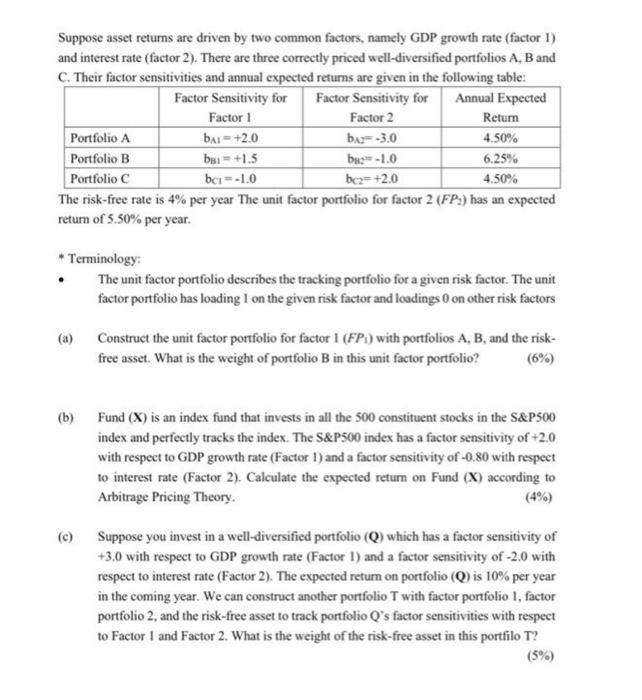*Please also show the steps in solving simultaneous equations in part (a).
Suppose asset returns are driven by two common factors, namely GDP growth rate (factor 1) and interest rate (factor 2 ). There are three correctly priced well-diversified portfolios A, B and C. Their factor sensitivities and annual expected returns are given in the following table: The risk-free rate is 4% per year The unit factor portfolio for factor 2 ( FP2) has an expected return of 5.50% per year. * Terminology: - The unit factor portfolio describes the tracking portfolio for a given risk factor. The unit factor portfolio has loading 1 on the given risk factor and loadings 0 on other risk factors (a) Construct the unit factor portfolio for factor 1 ( FP1) with portfolios A,B, and the riskfree asset. What is the weight of portfolio B in this unit factor portfolio? (6%) (b) Fund (X) is an index fund that invests in all the 500 constituent stocks in the S\&P500 index and perfectly tracks the index. The S\&P500 index has a factor sensitivity of +2.0 with respect to GDP growth rate (Factor 1 ) and a factor sensitivity of -0.80 with respect to interest rate (Factor 2). Calculate the expected return on Fund (X) according to Arbitrage Pricing Theory. (4%) (c) Suppose you invest in a well-diversified portfolio (Q) which has a factor sensitivity of +3.0 with respect to GDP growth rate (Factor 1 ) and a factor sensitivity of -2.0 with respect to interest rate (Factor 2). The expected return on portfolio (Q) is 10% per year in the coming year. We can construct another portfolio T with factor portfolio 1 , factor portfolio 2, and the risk-free asset to track portfolio Q 's factor sensitivities with respect to Factor I and Factor 2. What is the weight of the risk-free asset in this portfilo T? (5%) Suppose asset returns are driven by two common factors, namely GDP growth rate (factor 1) and interest rate (factor 2 ). There are three correctly priced well-diversified portfolios A, B and C. Their factor sensitivities and annual expected returns are given in the following table: The risk-free rate is 4% per year The unit factor portfolio for factor 2 ( FP2) has an expected return of 5.50% per year. * Terminology: - The unit factor portfolio describes the tracking portfolio for a given risk factor. The unit factor portfolio has loading 1 on the given risk factor and loadings 0 on other risk factors (a) Construct the unit factor portfolio for factor 1 ( FP1) with portfolios A,B, and the riskfree asset. What is the weight of portfolio B in this unit factor portfolio? (6%) (b) Fund (X) is an index fund that invests in all the 500 constituent stocks in the S\&P500 index and perfectly tracks the index. The S\&P500 index has a factor sensitivity of +2.0 with respect to GDP growth rate (Factor 1 ) and a factor sensitivity of -0.80 with respect to interest rate (Factor 2). Calculate the expected return on Fund (X) according to Arbitrage Pricing Theory. (4%) (c) Suppose you invest in a well-diversified portfolio (Q) which has a factor sensitivity of +3.0 with respect to GDP growth rate (Factor 1 ) and a factor sensitivity of -2.0 with respect to interest rate (Factor 2). The expected return on portfolio (Q) is 10% per year in the coming year. We can construct another portfolio T with factor portfolio 1 , factor portfolio 2, and the risk-free asset to track portfolio Q 's factor sensitivities with respect to Factor I and Factor 2. What is the weight of the risk-free asset in this portfilo T? (5%)







